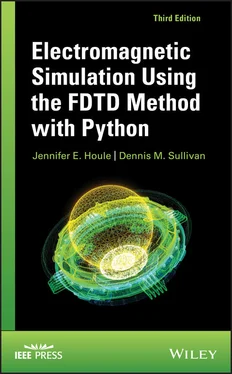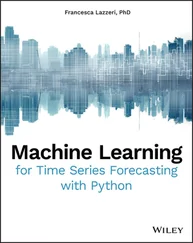9 5 ADVANCED PYTHON FEATURES 5.1 CLASSES PROBLEM SET 5.1 5.2 PROGRAM STRUCTURE PROBLEM SET 5.2.1 PROBLEM SET 5.2.2 5.3 INTERACTIVE WIDGETS PROBLEM SET 5.3
10 6 DEEP REGIONAL HYPERTHERMIA TREATMENT PLANNING 6.1 INTRODUCTION 6.2 FDTD SIMULATION OF THE SIGMA 60 6.3 SIMULATION PROCEDURE 6.4 DISCUSSION REFERENCES
11 APPENDIX A: THE Z TRANSFORMTHE Z TRANSFORM A.1 THE SAMPLED TIME DOMAIN AND THE Z TRANSFORM A.2 EXAMPLES A.3 APPROXIMATIONS IN GOING FROM THE FOURIER TO THE Z DOMAIN PROBLEM SET A REFERENCES
12 APPENDIX B: ANALYTIC SOLUTION TO CALCULATING THE ELECTRIC FIELDANALYTIC SOLUTION TO CALCULATING THE ELECTRIC FIELD REFERENCE
13 INDEX
14 END USER LICENSE AGREEMENT
1 Chapter 2Table 2.1 Properties of Human Muscle
2 Chapter 5Table 5.1 Breakdown of PML Parameters
3 Appendix ATable A.1 Some Z TransformsTable A.2 Properties of Z Transforms
1 Chapter 1 Figure 1.1 Interleaving of the E and H fields in space and time in the FDTD ... Figure 1.2 FDTD simulation of a pulse in free space after 100 time steps. Th... Figure 1.3 Simulation of an FDTD program with absorbing boundary conditions.... Figure 1.4 Simulation of a pulse striking dielectric material with a dielect... Figure 1.5 Simulation of a propagating sinusoidal wave of 700 MHz striking a... Figure 1.6 Simulation of a propagating sinusoidal wave striking a lossy diel...
2 Chapter 2Figure 2.1 Simulation of a pulse striking a dielectric medium with ε r=...Figure 2.2 (a) Relative dielectric constant and (b) conductivity as function...Figure 2.3 Simulation of a pulse striking a frequency‐dependent dielectric m...Figure 2.4 Simulation of a wave propagating in free space and striking a pla...Figure 2.5 Simulation of a wave propagating in free space and striking a pla...Figure 2.6 (a) Relative dielectric constant and (b) conductivity as function...
3 Chapter 3Figure 3.1 Interleaving of the E and H fields for the two‐dimensional TM for...Figure 3.2 Results of a simulation using the program fd2d_3_1.py. A Gaussian...Figure 3.3 Parameters related to the perfectly matched layer (PML).Figure 3.4 Results of a simulation using the program fd2d_3_2.py. A sinusoid...Figure 3.5 Total field/scattered field of the two‐dimensional problem space....Figure 3.6 Every point is in either the total field or the scattered field....Figure 3.7 Simulation of a plane wave pulse propagating in free space. The i...Figure 3.8 Simulation of a plane wave striking a dielectric cylinder. The fi...Figure 3.9 Simulation of a plane wave impinging on a dielectric cylinder. Th...Figure 3.10 Comparison of the FDTD results (solid lines) with the Bessel fun...
4 Chapter 4Figure 4.1 The Yee cell.Figure 4.2 A dipole antenna. The FDTD program specifies the metal arms of th...Figure 4.3 E zfield radiation from a dipole antenna in a three‐dimensional F...Figure 4.4 Radiation from a dipole antenna in an FDTD program with a seven‐poi...Figure 4.5 Total/scattered field in three dimensions.Figure 4.6 Total/scattered field boundary at k = ka .Figure 4.7 Comparison of the FDTD calculation (lines) with the Bessel functi...Figure 4.8 E zis calculated by the surrounding H xand H yvalues. The paramet...Figure 4.9 Comparison of the FDTD calculation (lines) with the Bessel functi...
5 Chapter 5Figure 5.1 Main program flow for fd3d_5_1.py.Figure 5.2 Window created using the Controllerclass. This displays the outp...
6 Chapter 6Figure 6.1 A diagram indicating the Sigma 60 applicator placed around the pa...Figure 6.2 Axial view of the Sigma 60 annular phased array.Figure 6.3 An illustration of the FDTD problem space containing the Sigma 60...Figure 6.4 FDTD model of the dipole antennas.Figure 6.5 The Hx field in front of the dipole is an indication of current f...Figure 6.6 The amplitude of the Fourier transform of Hx in front of the dipo...Figure 6.7 Illustration of the radiation from quadrant 1 for 300, 500, 600, ...Figure 6.8 Test configuration to evaluate the frequency response of the dipo...Figure 6.9 Output of the test illustrated in Fig. 6.5.Figure 6.10 Contour diagrams of the GAZ parameter illustrating how the patie...Figure 6.11 Flow chart of the treatment planning system.Figure 6.12 The operator specifies a target point (ipos,jpos) and the phases...Figure 6.13 The resulting SAR distributions for four different settings. The...
7 Appendix AFigure A.1 The response of Eq. (A.18) to a step function input, that is, x [ n
1 Cover
2 Table of Contents
3 Begin Reading
1 ii
2 iii
3 iv
4 v
5 ix
6 xi
7 xii
8 xiii
9 xiv
10 xv
11 xvi
12 1
13 2
14 3
15 4
16 5
17 6
18 7
19 8
20 9
21 10
22 11
23 12
24 13
25 14
26 15
27 16
28 17
29 18
30 19
31 20
32 21
33 22
34 23
35 24
36 25
37 26
38 27
39 28
40 29
41 30
42 31
43 32
44 33
45 34
46 35
47 36
48 37
49 38
50 39
51 40
52 41
53 42
54 43
55 44
56 45
57 46
58 47
59 48
60 49
61 50
62 51
63 52
64 53
65 54
66 55
67 56
68 57
69 59
70 60
71 61
72 62
73 63
74 64
75 65
76 66
77 67
78 68
79 69
80 70
81 71
82 72
83 73
84 74
85 75
86 76
87 77
88 78
89 79
90 80
91 81
92 82
93 83
94 84
95 85
96 86
97 87
98 88
99 89
100 90
101 91
102 92
103 93
104 94
105 95
106 96
107 97
108 99
109 100
110 101
111 102
112 103
113 104
114 105
115 106
116 107
117 108
118 109
119 110
120 111
121 112
122 113
123 114
124 115
125 116
126 117
127 118
128 119
129 120
130 121
131 122
132 123
133 124
134 125
135 126
136 127
137 129
138 130
139 131
140 132
141 133
142 134
143 135
144 136
145 137
146 138
147 139
148 140
149 141
150 142
151 143
152 144
153 145
154 146
155 147
156 148
157 149
158 150
159 151
160 152
161 153
162 154
163 155
164 156
165 157
166 158
167 159
168 160
169 161
170 162
171 163
172 164
173 165
174 166
175 167
176 168
177 169
178 170
179 171
180 172
181 173
182 174
183 175
184 176
185 177
186 178
187 179
188 180
189 181
190 183
191 184
192 185
193 186
194 187
195 188
196 189
197 190
198 191
199 192
200 193
201 194
202 195
203 196
204 197
205 198
206 199
IEEE Press445 Hoes Lane Piscataway, NJ 08854
IEEE Press Editorial BoardEkram Hossain, Editor in Chief
| David Alan Grier |
Andreas Molisch |
Diomidis Spinellis |
| Donald Heirman |
Saeid Nahavandi |
Sarah Spurgeon |
| Elya B. Joffe |
Ray Perez |
Ahmet Murat Tekalp |
| Xiaoou Li |
Jeffrey Reed |
|
ELECTROMAGNETIC SIMULATION USING THE FDTD METHOD WITH PYTHON
Читать дальше












